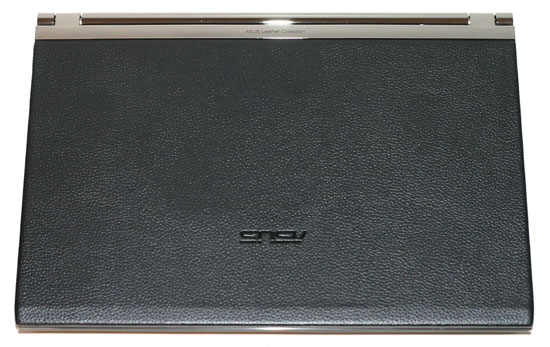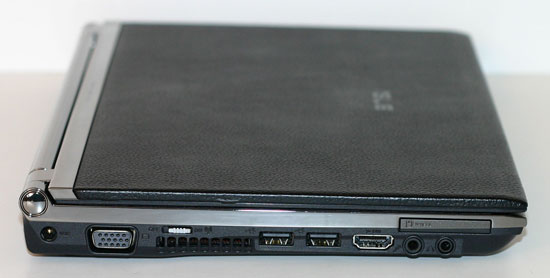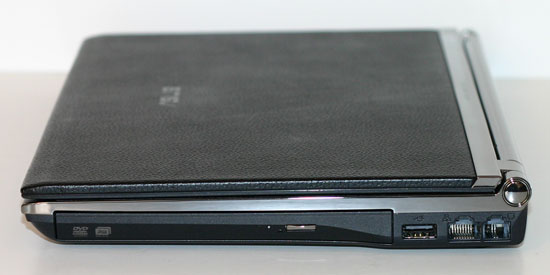Genuine Bovine Beauty
The ASUS U2E definitely sits apart from other notebooks when it comes to external appearance. Fundamentally, you're still using a laptop, but as companies like Apple have proven repeatedly, appearance can be the difference between an average consumer electronics device and the next great must-have item. So what does ASUS do that people haven't seen a thousand times before? It's quite simple: they surface the top of the laptop and the wrist pads with genuine leather.
Is that enough to grab the attention of potential customers? Perhaps not, but it's not difficult to imagine an executive with a nice leather office taking one look at the U2E and deciding that it's the perfect new laptop. It's also available in brown or black leather, so it should have no problem blending in with most conservative offices (or perhaps car interiors). The leather inlays are not just a quick hack job either. ASUS states that they hand select the leather pieces that will be used on their notebooks.
ASUS continues the executive motif with polished stainless steel accents. They even go so far as to state that the hinge between the LCD and the main laptop is "inspired by a masterpiece cufflink". Mere hyperbole or can they back up these lofty claims? We'll let you be the judge, but we personally think this is a very nice looking laptop.
 |
 |
 |
 |
 |
 |
One of the big problems with small laptops is the keyboard. Some people are able to adapt easier to laptop keyboards than others, but there's definitely a limit to how small you can make a keyboard before you sacrifice maximum typing speed. ASUS definitely passed that boundary with their Eee PC; personally, I found my typing speed cut in half on the Eee PC. It's amazing what a big difference a few extra inches makes. (Ed: Despite claims to the contrary, size does matter!)
The U2E doesn't quite have a full-size keyboard, but the key size and spacing is so close to normal that it's difficult to tell the difference. After a short time spent with the laptop on a regular basis, I was able to type at 80 to 90% of my normal speed. Users who are happy with ergonomic "natural" keyboards (like myself) will still likely experience some discomfort using the keyboard for extended periods of time, but in trying to strike a balance between size and usability, the 11.1" chassis is about as small as you can comfortably go before you encounter serious difficulties with keyboard size.
Besides the size and spacing of the keys, the overall keyboard layout is very good. All of the keys are exactly where I like them to be on a laptop, although opinions differ on where exactly the Fn key belongs relative to the control key. You will need to use an Fn key combination in order to access the Home/End/PgUp/PgDn keys, but short of making all of the keys smaller or increasing the size of the chassis there's no good way around that requirement.










32 Comments
View All Comments
sam13007 - Friday, November 6, 2009 - link
hi friendsplease what's the model of the motherboard of this asus U2E please friends answer me.
thanks
Anonymous Freak - Sunday, April 20, 2008 - link
[quote]We still think that it would have been nice if ASUS could have managed to provide easier access to the bottom memory socket.[/quote]Why? If they are going to ship it with a 2 GB module in there, why does it matter? The chipset only supports a max of 4 GB of RAM, so 2x2GB modules would get you there. Heck, if they were going to supply it with 3 GB of RAM, why not go the MacBook Air-route, and solder the 2 GB onboard to save space, leaving just the one SO-DIMM socket.
JarredWalton - Sunday, April 20, 2008 - link
I wrote that before finding out that ASUS was switching the lower socket to a 2GB SO-DIMM - or at least, that's what they say. But then, you never know if your RAM is going to go bad, and making it easy to replace never hurts. A small panel on the bottom could have made this tons easier.howardmoore - Monday, September 15, 2008 - link
Hi,Is there a way to find out whether the bottom SO-DIMM socket does have 2GB of RAM installed without having to take the thing apart?
I say that because I have a U2E and bought 2GB Ram upgrade (2 x 1GB) on the advice of Orca Logic in the UK. Before I upgraded it said that I had 2GB of Ram, though the chip that was already in the top tray was a 1GB. I presumed therefore that the bottom tray had 1GB also. When I installed one of my new 1GB chips into the spare top tray the upgraded RAM read 3GB, but I would have thought that:
a) If the bottom already had 2GB the top would have read 3GB already.
b) If I installed 1GB more into the top, it would read that I now had 4GB.
So, what to do!? Do I go through the laborious (and potentially dangerous for the laptop!) task of disassembly to see whether I can upgrade the bottom socket, or just live with 3GB? Also, is there a problem with the two sockets being on different amounts - I read somewhere that they had to have the same memory amounts to work effectively. Finally, why cannot I not see 4GB showing?
Thanks in advance for any responses.
JarredWalton - Monday, September 15, 2008 - link
You can use CPU-Z (from www.cpuid.com) to see what memory is installed.Nimbo - Thursday, April 17, 2008 - link
3 years ago I could buy a 10.6' laptop with centrino platform (1.1GHz) 512MB and 80GB HDD for $1000 and DVD CDRW combo for $1000. How come a similar laptop with updated to today's hardware it's dobled in price. Back then the ultra small laptops were not regarded as special and Averatec did not charched a premium because of the form factor.Asus should follow the same path and de-primiumaze this niche market so I can aforded again.
JarredWalton - Thursday, April 17, 2008 - link
The ASUS Eee PC 900 series takes care of the lower spec market, I suppose. It seems that the ultraportable market has either become lucrative due to business interest, or perhaps there just aren't enough customers so they need to recoup the R&D expenses. The specs of a modern ultraportable are quite a bit better than the three year old stuff, though.kmmatney - Wednesday, April 16, 2008 - link
It would be nice if the optical drive could be swapped out with other hardware, like an extra battery or another hard drive...IvanAndreevich - Tuesday, April 15, 2008 - link
Last time I used the optical drive on my laptop was to install the O/S. Really, I would prefer my T60 didn't have one. As for this, it would be a much better thing to have the full 2.5" HDD, and perhaps a slightly bigger battery, or faster processor instead of the aforementioned optical drive.I also have an IBM X31 without an optical drive, and it doesn't bother me a bit.
strikeback03 - Wednesday, April 16, 2008 - link
I use the optical drive on my T43 quite a bit for watching DVDs, burning the occasional disc, and loading programs. Plus the bay can hold another battery or hard drive. Too bad ASUS couldn't fit that functionality into the U2E, would let most people be happy with what they put in the bay.